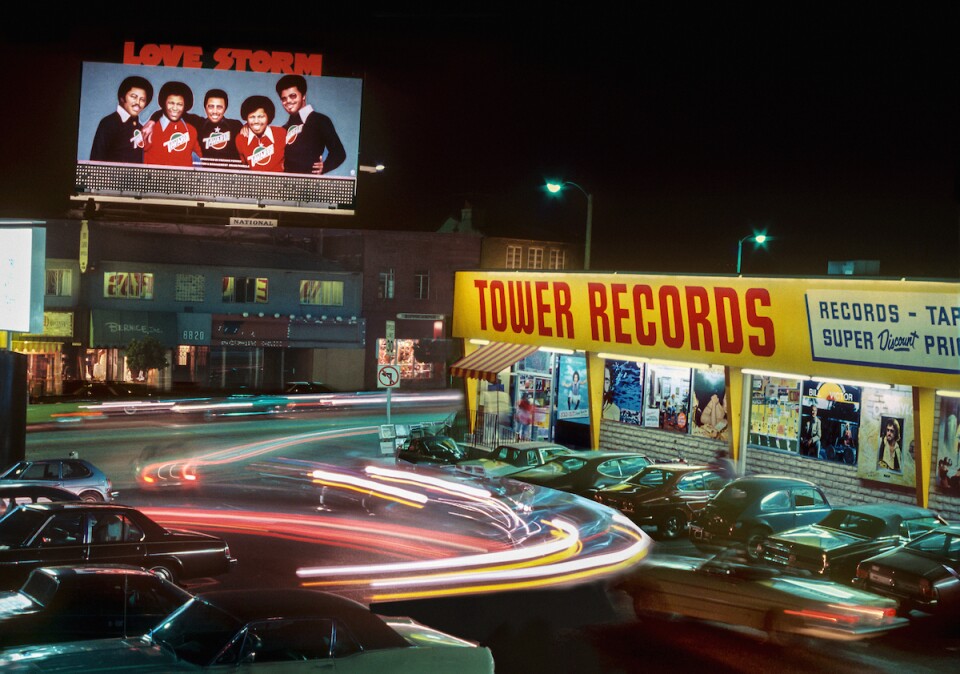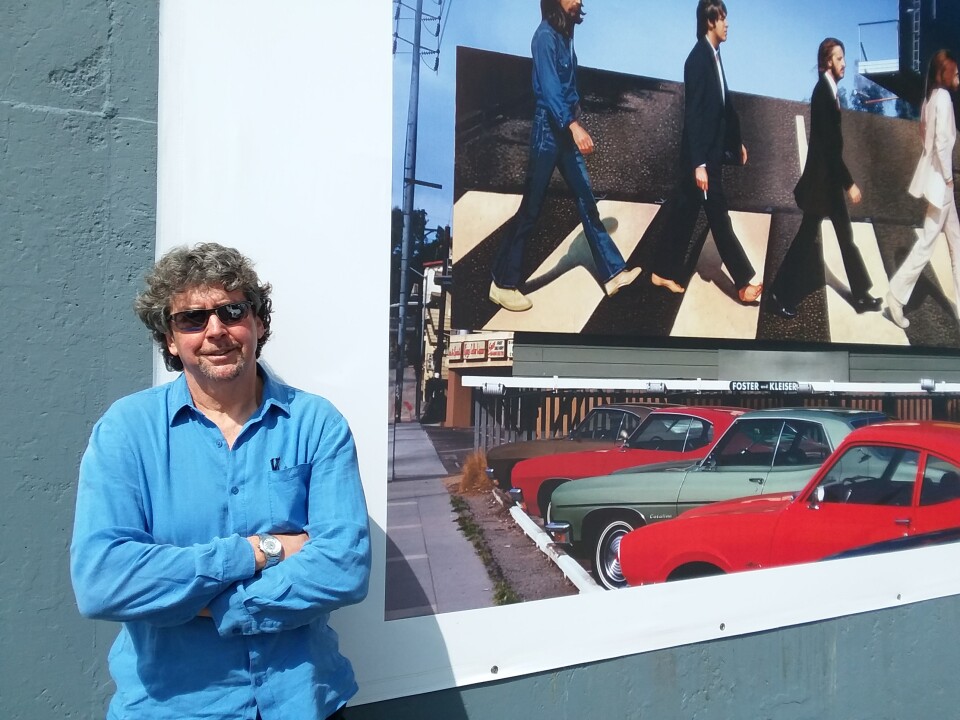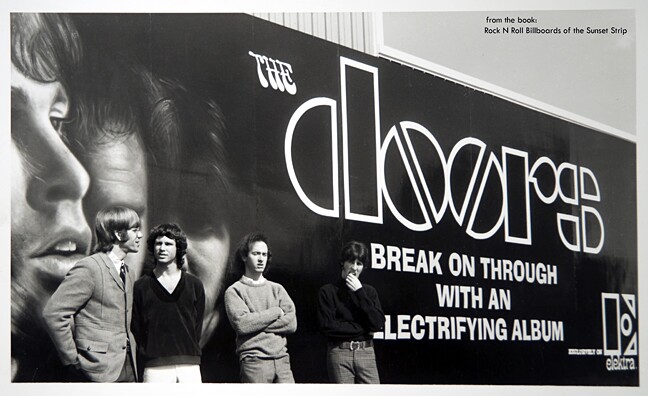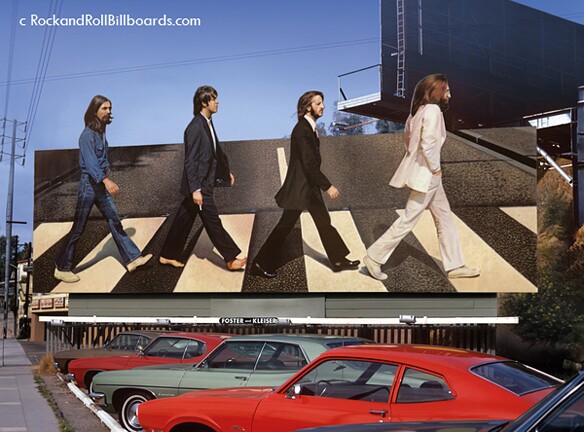Now that the Writer's Guild strike has been authorized, we welcome Miranda Banks, author of the book, “The Writers: A History of American Screenwriters and Their Guild” for some background on this influential guild; We take look at the history of the Sunset Strip's role as an outdoor gallery for billboards promoting rock albums; The new documentary “Casting JonBenet” takes a different look at the unsolved 1996 murder of six-year-old JonBenet Ramsey.
Revisiting the Golden Age of rock billboards on the Sunset Strip
If you drove down the Sunset Strip in the late 1960s, you were treated to what was essentially an outdoor rock-and-roll art gallery.
While psychedelic music poured out of the clubs, record stores and head shops along Sunset, the latest albums were being celebrated on gigantic billboards high above the street. But it wasn’t always that way. The very first rock billboard arrived on the strip 50 years ago – just in time for the Summer of Love.
“It was this really unique period where art and culture merged and the '60s generation was sort of coming of age,” says photographer Robert Landau. “I think it was a really special time in a lot of ways.”

Landau spent 10 years photographing the billboards on the Strip – producing what might be the most complete record of this largely unheralded art form. His photographs are collected in his book, “Rock ‘N’ Roll Billboards of the Sunset Strip” (Angel City Press). It all started in 1969, when Landau was just a shy teenager with a camera – and the Sunset Strip was his front yard.
“My dad had a bachelor pad right above the Strip here,” Landau recalls. “And I was 15. I'd walk down here with my camera, getting into photography. And I'd see John Lennon and the Beatles 15-feet-high, and some guy up there painting them.”
Each day on his way to school, Landau watched as his rock heroes took over the billboards on the strip, changing every month.
“About three weeks later, they’d paint it over with a new message,” he continues. “I knew they weren't around long. So I knew when I saw one I liked, I'd better get a picture or it'd be gone. I just started photographing them, and it became kind of an obsession for about 10 years.”

Of course, there have been billboards on Sunset as long as there have been cars. But up until the '60s, they were mainly ads for the usual products – cars, whiskey, TV shows and Vegas acts.
Then, in 1967, an executive at Elektra Records had a radical idea. He’d noticed that all the radio DJs took Sunset on their way to work in Hollywood – and he wanted their attention.
“Jac Holzman got the idea that a rock-and-roll billboard should be up there, selling a record album,” Landau says. “And he had the perfect album.”
The Doors were an L.A. band, born on the strip, wildly popular and about to make it big — Elektra was releasing its debut album. And when Holzman hung their four faces high above Sunset, he wasn’t so much trying to sell records as making a statement: The Doors are here, and Elektra’s got 'em!

“No other company was doing that,” recalls Robbie Krieger, the band’s guitarist. “They didn't know if they were gonna make their money back on something like that. It was just more of an ego trip, I would say, for the record company and us.”
“We used to drive by every day and look at it — kinda hold up traffic."
As Krieger leafs through Landau’s book, he recalls the day the billboard was erected on the Strip. With the entire band on hand, Elektra made sure the event was well publicized. Krieger stops at an image of the four of them — Jim Morrison, Ray Manzarek, John Densmore and himself — perched high on top of the billboard.
“Oh yeah, they let us go up on top!” Krieger chuckles. “That would never happen today. But we hung out there for probably half-an-hour while they were putting it up … I'm amazed they let us sit there like that.”
Other labels caught on, and soon every major act saw its latest album immortalized on the Strip – The Who, The Rolling Stones, Crosby, Stills & Nash, Jimi Hendrix, Pink Floyd. And while promoting rock music with just an image might seem counterintuitive, for a generation used to obsessing over album covers in detail, music and art were almost the same thing. And, Landau adds, the billboards weren’t really about advertising, they were about communication — almost like sending a secret message to the fans.

“In a lot of cases they're not even telling you what they're selling,” Landau points out. We’re standing on the corner of Sunset and Holloway, where a selection of Landau’s images is on display throughout this year. He points to one image: a billboard showing a pig, a dog and a sheep – and not a word of text.
“If you didn't know that Pink Floyd had a record out called 'Animals,' you didn't know what they were advertising,” Landau remarks. “And they didn't care. It really wasn't about that.”
In the pre-MTV, pre-YouTube and pre-iTunes era, “The first way to get people's attention was through the album cover, the visual,” Landau adds. “And those visuals also became the billboards. So that's the connection.”
Landau photographed hundreds of billboards during rock’s heyday. His book is dedicated to the artists who created the billboards, many of which were hand-painted. Landau holds a special reverence for those artists, many of whom he got to know as he watched them at work on his daily walks.
“The billboards were an uncredited art form,” he says. “Nobody said who painted ‘em, who designed ‘em. Just the art of rendering these heads, at that size, was an incredible bit of craftsmanship, artistry, whatever you want to say, but it was really spectacular.
“Because when you get right up to any billboard, it looks like a series of splotches. These things are huge. And you don't really notice it driving by in your car, but you get up close and they're really large.”

One billboard was famously at the center of a crime that went unsolved for over four decades – Paul McCartney’s missing head. It all started with the release of the Beatles’ album, “Abbey Road,” in 1969. That year, you couldn’t escape the bizarre rumor that “Paul was dead.”
“People were playing the records backwards, looking for clues, and they even said that this image was sort of a funeral march because he's barefoot,” recalls Landau as we look at a photograph of the album’s billboard. Like the album cover, it features the Beatles in single file, crossing Abbey Road. Their heads are cutouts that extend above the billboard, silhouetted against the sky.
On the morning of December 23, 1969, Sunset Strip commuters saw what looked like the latest clue to McCartney’s demise – Paul’s head was missing from the billboard. Capitol Records sent the art director, Roland Young, out to investigate.
“He looks at it and they say, What do you want us to do? Should we replace the head?” says Landau. “And he says, No, leave it like that — it'll get a lot more attention!”
Young was right — the publicity certainly didn’t hurt record sales. But who was behind McCartney’s decapitation?

“My buddies helped me, and we did it on December 22nd, which was my birthday,” admits Robert Quinn. He was just turning 19 when he got the idea to pull off the heist. Quinn enlisted two accomplices, and around 2 a.m., they pulled up underneath the billboard in his vintage Volvo. One of the crew had brought along a Skilsaw. Within minutes, they had their prize.
“So we threw Paul’s head into the trunk of my car and took off,” Quinn laughs. “It was quick! If you were driving by, one second it was up there and the next it was gone.”
McCartney’s head hangs on Quinn’s living room wall to this day. And he may have unknowingly salvaged the only remaining relic of this chapter in rock history. Because once a rock star’s billboard came down at the end of the month, it was destroyed, gone forever – and replaced by the Next Big Thing.
Robert Landau will present a slideshow of historic billboards, along with stories of the counterculture era, at 7:30 pm. on April 26 at the West Hollywood Council Chambers. And you can see an outdoor exhibition of Landau’s photos at 8775 Sunset Boulevard throughout 2017. More info at www.rockandrollbillboards.com
'Casting JonBenet' is a new twist on the documentary format
More than 20 years after six-year-old JonBenet Ramsey was murdered in her Boulder, Colorado home, the unsolved case is still an endless source of public fascination.
There have been TV movies, documentaries and docudramas made about the case, but a new Netflix documentary being released on April 28 is something quite different.
“Casting JonBenet” is a documentary about the casting of a film about JonBenet Ramsey. The actors who are up for the roles are all from Boulder and surrounding areas. Their casting tapes and their personal stories about their connections to the Ramsey case are the basis of the film:
“Casting JonBenet” was directed by Australian filmmaker Kitty Green. She spoke with The Frame host John Horn about her unconventional twist on the documentary format.
Interview highlights:
On how she ended up taking this approach to a film about JonBenet Ramsey
It's a film that's structured around the casting of a movie about JonBenet Ramsey, so it's working on a few different levels. But I'd made a short film ["The Face of Ukraine: Casting Oksana Baiul"] with a similar concept that did quite well and won a prize at Sundance ... We made it in Ukraine about the conflict in Ukraine, but centered it around an audition piece for [figure skater] Oksana Baiul. So we got little girls to audition to play [her]. And so it became this kind of structural conceit, I like to call it. When it did well at Sundance, people wanted to know how we could do a similar thing in America and I just blurted, JonBenet Ramsey.
On how her short doc about Oksana Baiul and "Casting JonBenet" tell us more about ourselves than they do about the subjects of the films
With ["The Face of Ukraine"], I was trying to make a film about suffering during wartime that wasn't propaganda for either side, so I was just looking to document human suffering essentially. And once you sit people down and ask them how they're doing and how they would play a role like this, people just tell you about their own stories and their own pain and their own kind of emotional baggage. And I found it opened people up in different ways, so we used the same thing with the Ramsey case where we would sit people down and say, What do you know about the JonBenet Ramsey case? And they would immediately launch into not only what they think about the case, but their own backgrounds ... immediately they're on their own trajectory. So that became really interesting to me — how people deal with an unsolved crime and [how] they go emotionally inwards in order to comes to terms with something.
On what the actors who auditioned for the parts were told about what "Casting JonBenet" was about
We told them they're going to be part of an experiment, basically. That their casting material will be used in the film. It's a film about the making of a film, that multiple people may play certain roles. Will you jump down the rabbit hole with us? is basically what we asked them.
On why she thinks the actors were so open about their own lives
I'm not sure, honestly ... I'm Australian and we're not like that. It's a very American thing. You throw a camera in front of a lot of people here and people just love to talk. And people, I think, found it cathartic to just tell me stories and chat. And we were very honest about what we were trying to achieve. I think they respected that and were honest back with us.
On what's behind the public fascination with the JonBenet Ramsey case
There's a few things. Firstly, it's one of the weirdest cases around. I think it's weirder than "Twin Peaks." She's six-years-old, it's Christmas night, Santa is a suspect. There's pageantry, there's glitz, there's glamour, they're wealthy. But also, I think inherently it's a family story. It's about a mother and a father and a brother and a sister and we can relate to that in some ways, so I think each of us can [think], Well, my mother used to snap occasionally if I didn't do this or that. I think people have a personal connection often to what happened in the house that night and exactly how it went down, so I think there's a few elements at play.
To hear the full interview with Kitty Green, click the blue player above.




